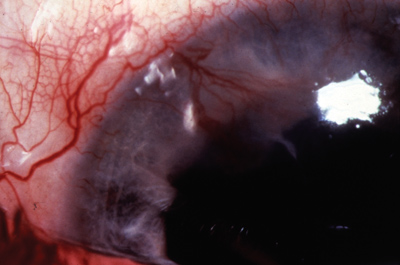
A: PDT is an option, according to a case report published in Cornea.1 Researchers from Italy treated two CNV patients with a nonthermal 689nm laser 15 minutes after intravenous verteforfin infusion.
Results showed an immediate successful photothrombosis in both patients, and corneal fluorescein and indocyanine green (ICG) angio-graphy verified vessel regression. Both patients were followed for a minimum of six months after the procedure. After the first month, one of the patients had partial vessel recanalization and required a repeat treatment. The second treatment caused the new vessels to completely regress. No major side effects were noted in either patient.
 |
|
Severe neovascularization in a similar patient. |
Further, even if a large-scale study does validate PDT as safe and effective, it is not going to prevent neovascularization from recurring if the patient resumes wearing the low Dk/t first-generation hybrid lens, adds Dr. Chou. The resulting hypoxia from the first-generation hybrid lens would likely induce vessel regrowth, he says. To me, addressing the causative factorthe low oxygen supply of the lensrather than its manifestation, makes more sense. So, refit this patient into a healthier alternative lens.
His suggestions: SynergEyes KC (SynergEyes, Inc.), a new high Dk/t hybrid lens specifically designed for keratoconus patients; a semi-scleral large diameter lens such as the Macrolens Jupiter Lens (C&H Labs Innovations in Sight); or the Dyna Intralimbal Lens (Lens Dynamics).
However, even a new generation hybrid lens will likely contribute to the problem unless there is at least some vessel regression.
Because multiple treatments may be required with PDT, ophthalmologist Perry S. Binder, M.D., of San Diego, recommends a recently discovered permanent solution. Ophthalmologist Jrg H. Krumeich, of Bochom, Germany, photographically documented no progression of pre-existing blood vessels in corneal transplanted eyes after the implantation of metal rings in the corneal stroma, Dr. Binder says.2
Another advance to help keratoconus patients was recently presented by Swiss ophthalmologist Theo Seiler, an invited speaker at the Fifth World Cornea Congress, held in Washington, D.C. He revealed that a yellow-light treatment is a permanent fix for shrinking the collagen fibers and flattening the cone, says attendee Robert Abel, Jr., M.D., of Wilmington, Del.
Researchers painted a yellow dye to the tip of the cone and then utilized a diode laser of approximately 680nm to shrink the cone, Dr. Abel explains. After five years of study, the researchers showed that keratoconus patients who were previously considered contact lens failures can often return to contact lens wear.
In this case, prescribe a mild topical steroid and a high Dk/t contact lens. Fitting a gas permeable lens alone or in combination with a silicone hydrogel piggy back system may work best, since there is already significant vascularization. If vessel regression occurs, prescribe a new generation hybrid lens.
1. Fossarello M, Peiretti E, Zucca I, Serra A. Photodynamic therapy of corneal neovascularization with verteporfin. Cornea 2003 Jul;22(5):485-8.
2. Krumeich, J.H. A fortunate chance for penetrating keratoplasties/ISCR (Krumeich Ring.). European Ophthalmology News XXIII Congress of the European Society of Cataract and Refractive Surgeons. 2005 Oct;14(09):18-19.

